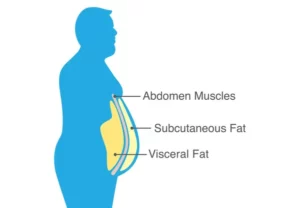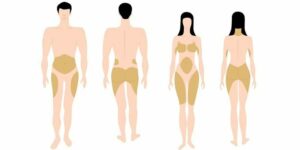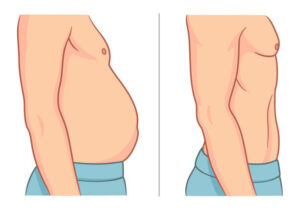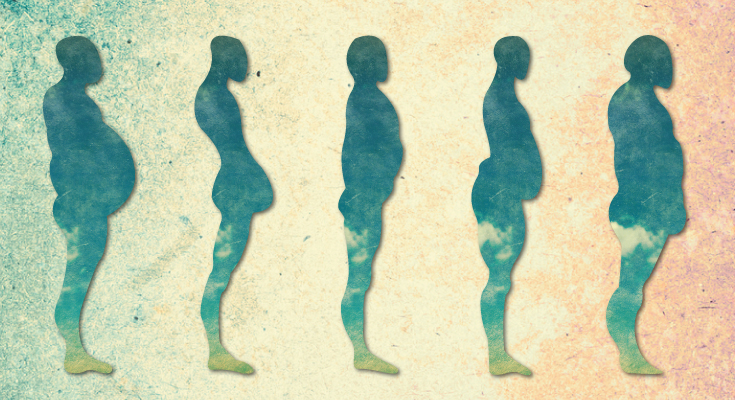Do you have a little too much belly fat? Are you concerned about your health? You should be! Excess belly fat is not only unsightly, but it can also lead to some very serious health problems. In this blog post, we will discuss different types of belly fat that you need to be aware of.
Contents
What Is Belly Fat?
Belly fat is the accumulation of fats around the abdominal organs. Belly fat is more dangerous because it secretes hormones such as leptin and adiponectin, which can lead to health problems like type II diabetes and heart disease. Although you can’t spot reduced belly fat, there are certain types of belly fat that are more dangerous than others.
Different Types Of Belly Fat
 If you’re like most people, when you think about belly fat, you think about that extra layer of fluff around your waistline. But did you know that there are actually different types of belly fat? Here’s a breakdown of the different types of belly fat:
If you’re like most people, when you think about belly fat, you think about that extra layer of fluff around your waistline. But did you know that there are actually different types of belly fat? Here’s a breakdown of the different types of belly fat:
Subcutaneous Fat
 This is the type of fat that you can see and pinch. It’s the layer of fat right under your skin. Subcutaneous fat is usually not a big health concern and can be burned off through exercise and a healthy diet. To get rid of subcutaneous fat, you need to do some form of cardiovascular exercise like running, biking, or swimming for at least 30 minutes a day. Below are some of the types of subcutaneous belly fat:
This is the type of fat that you can see and pinch. It’s the layer of fat right under your skin. Subcutaneous fat is usually not a big health concern and can be burned off through exercise and a healthy diet. To get rid of subcutaneous fat, you need to do some form of cardiovascular exercise like running, biking, or swimming for at least 30 minutes a day. Below are some of the types of subcutaneous belly fat:
Lower Belly Fat
Lower belly fat is a type of subcutaneous fat that is present in the lower half of your stomach. This type of belly fat can be a result of genetic factors or lifestyle choices. Studies suggest that lower belly fat is more difficult to lose than other types of fat.
Love Handles
Love handles are a type of subcutaneous fat that sits on the sides of your waist. They are often one of the first places that people notice when they start to gain weight. Love handles may result from excess calories, genetics, or a sedentary lifestyle.
Muffin Top
A muffin top is a type of subcutaneous fat that sits on the top of your waist. It’s often caused by wearing tight clothing or carrying extra weight around your middle. It is the type of belly fat that is most resistant to diet and exercise.
Pooch Belly
A pooch belly is a type of subcutaneous fat that hangs over your waistline. The main cause of pooch belly fat can be carrying extra weight or genetics. It is believed that pooch belly fat is very difficult to lose and may require surgery to remove.
Belly Bulge
A belly bulge is a type of subcutaneous fat that can be difficult to get rid of. It is caused due to a combination of factors like genetics, lifestyle choices, and carrying extra weight around your middle.
Abdominal Fat
 This is the type of belly fat that’s stored in your abdominal cavity. Abdominal fat is more difficult to lose than subcutaneous fat and is a major health concern. Too much abdominal fat can lead to insulin resistance, type II diabetes, heart disease, and stroke. To get rid of abdominal fat, you need to do a combination of cardiovascular exercise and strength training. It might take longer to see results, but it’s worth it!
This is the type of belly fat that’s stored in your abdominal cavity. Abdominal fat is more difficult to lose than subcutaneous fat and is a major health concern. Too much abdominal fat can lead to insulin resistance, type II diabetes, heart disease, and stroke. To get rid of abdominal fat, you need to do a combination of cardiovascular exercise and strength training. It might take longer to see results, but it’s worth it!
Visceral Fat
 This is the type of belly fat that surrounds your organs. Visceral fat is dangerous because it can lead to a host of health problems including heart disease, type II diabetes, and breast cancer. To get rid of visceral fat, you need to eat a healthy diet and exercise regularly. Different types of visceral belly fat are as follows:
This is the type of belly fat that surrounds your organs. Visceral fat is dangerous because it can lead to a host of health problems including heart disease, type II diabetes, and breast cancer. To get rid of visceral fat, you need to eat a healthy diet and exercise regularly. Different types of visceral belly fat are as follows:
Spare Tire
A spare tire is a type of visceral fat that surrounds your organs. It’s been linked to an increased risk of heart disease, diabetes, and even certain types of cancer like colon cancer.
Beer Belly
A beer belly is a type of visceral fat that is defined as a protruding stomach that is the result of excess abdominal fat. Beer bellies are often caused by excessive alcohol consumption, but they can also be the result of eating too many high-calorie foods and lack of exercise. To get rid of a beer belly, you need to cut back on your alcohol intake and make sure you’re eating a healthy diet and exercising regularly. It’s often caused by drinking too much alcohol.
Hormonal Fat
 This type of belly fat is caused by hormones like estrogen and cortisol. Hormonal fat is more common in women and can be very difficult to lose. To get rid of hormonal fat, you need to eat a healthy diet, exercise regularly, and take care of your stress levels. Attaining hormonal balance is essential for getting rid of this type of fat.
This type of belly fat is caused by hormones like estrogen and cortisol. Hormonal fat is more common in women and can be very difficult to lose. To get rid of hormonal fat, you need to eat a healthy diet, exercise regularly, and take care of your stress levels. Attaining hormonal balance is essential for getting rid of this type of fat.
Risk Factors
 Belly fat is not just a cosmetic issue; it is also linked to an increased risk of type II diabetes, cardiovascular disease, and diseases like Alzheimer’s and Parkinson’s.
Belly fat is not just a cosmetic issue; it is also linked to an increased risk of type II diabetes, cardiovascular disease, and diseases like Alzheimer’s and Parkinson’s.
There are several risk factors for belly fat, including:
Unhealthy diet
An unhealthy diet could be a major factor in the development of belly fat. A diet that is high in calories, saturated fats, and refined carbs can lead to weight gain and abdominal obesity. Eating Junk food also plays a role in the development of belly fat. Healthy eating habits, such as consuming more fruits, vegetables, and whole grains, are linked with a lower risk of abdominal obesity.
Lack of exercise
Lack of exercise is another major factor in the development of belly fat. People who are inactive and have a sedentary lifestyle have a higher risk of developing visceral fat than people who are active. Doing regular and simple exercises like walking, and jogging can help in reducing belly fat.
Stress
Chronic stress is another factor that can lead to the development of belly fat. When you are stressed, your body releases a hormone called cortisol. Cortisol has been linked to weight gain, especially around the abdominal area, and leads to the accumulation of visceral fat. Managing stress levels can help reduce the risk of developing belly fat.
Genetics
Genetics may play a role in the development of belly fat. Some people are more likely to develop visceral fat than others because of their genes. If you have a family history of abdominal obesity, you may be more likely to develop it yourself. In order to prevent the development of belly fat, it is important to maintain a healthy lifestyle to prolong the health of your genes.
Age
As we age, our bodies change and we become less active. This can lead to an increase in visceral fat. With age, comes various lifestyle changes, such as retirement, that can also lead to a sedentary lifestyle and an increased risk of developing belly fat.
Gender
Gender also plays a role in the development of belly fat. Men are more likely to develop visceral fat than women. This may be because of hormones, such as testosterone, that play a role in the development of abdominal fat. Also, women tend to store fat differently than men and tend to have more subcutaneous fat, which is the type of fat that is found under the skin.
Pregnancy
Pregnancy can also lead to the development of belly fat. During pregnancy, the body stores more amount of fat in order to provide energy for the growing baby. This can lead to an increase in weight and abdominal girth. After pregnancy, it can be difficult to lose the extra weight and many women are left with excess belly fat.
Sleep deprivation
Getting enough sleep is important for overall health, and a lack of it may also play a role in the development of belly fat. Sleep deprivation can lead to weight gain and abdominal obesity. A higher risk of development of visceral fat is observed in people who are sleep-deprived than in people who are not. An adequate amount of sleep is important for maintaining a healthy lifestyle and preventing the development of belly fat.
Certain medical conditions
Certain medical conditions, such as polycystic ovary syndrome (PCOS), can lead to weight gain and abdominal obesity. Medical conditions that are associated with inflammation, such as Cushing’s syndrome and inflammatory bowel disease (IBD), can also lead to the accumulation of visceral fat. Avoidable medical conditions, such as diabetes and high cholesterol, are also risk factors for the development of belly fat.
Smoking
Smoking is a major risk factor for the development of belly fat. People who smoke have a higher risk of developing visceral fat than people who do not smoke. Smoking cigarettes releases harmful chemicals that can damage your health and lead to weight gain. Quitting smoking is one of the best things you can do for your health and may help reduce your risk of developing belly fat.
Tips To Reduce Belly Fat
- Eating a healthy diet
- Exercising regularly
- Reducing stress levels
- Getting enough sleep
- Limiting alcohol intake
- Avoiding smoking
- Managing medical conditions
- Making lifestyle changes
If you are concerned about your weight or the amount of belly fat you have, talk to the health professionals at Mantra Care. They can help you determine if you are at risk for any health conditions and provide tips on how to improve your lifestyle and lose weight. Remember, making small changes in your diet and lifestyle can lead to big results.
Conclusion
Belly fat is a type of fat that accumulates around the abdomen and is a risk factor for various health conditions. There are different types of belly fat, including visceral fat, subcutaneous fat, and abdominal obesity. Belly fat is harmful to your health and leads to changes in your physical appearance as well. It might become the cause of your mental distress too. Losing weight and reducing belly fat can improve your health and reduce your risk of developing various health conditions. You need to be patient and consistent with your efforts to see results. Take one step at a time and see the difference it makes in your life.
For more tips on healthy eating and weight loss, contact Mantra Care. We can help you develop a healthy weight loss plan that is tailored to your specific needs and goals. As always, consult with a registered dietitian or nutritionist if you have any questions or concerns about starting a new diet.


